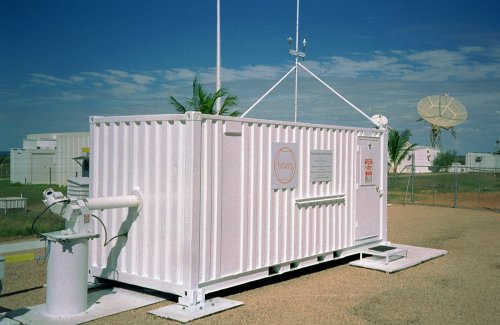
 Copyright © Michael Richmond.
This work is licensed under a Creative Commons License.
Copyright © Michael Richmond.
This work is licensed under a Creative Commons License.
We can't see inside the Sun in ordinary visible light directly, because gas in the photosphere is so dense that it absorbs and scatters all photons coming from below. However, we can use visible light to probe the solar interior indirectly, by looking at very subtle pulsations of the photosphere. It's like trying to figure out the shape and structure of a bell by listening to the sound it makes.
The GONG project uses small telescopes here on Earth to study motions of gas in the Sun's photosphere. The instrument doesn't look all that impressive:

The telescope is connected to the arm sticking out the side of the container, on the left:
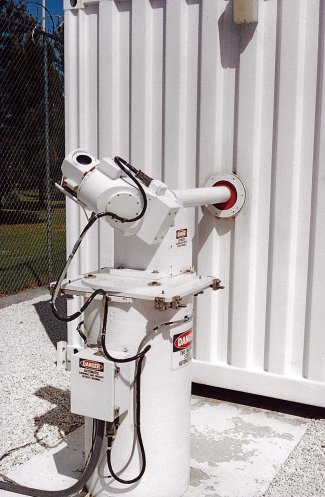
Light from the Sun passes through a filter and then is fed into a sophisticated spectrograph:
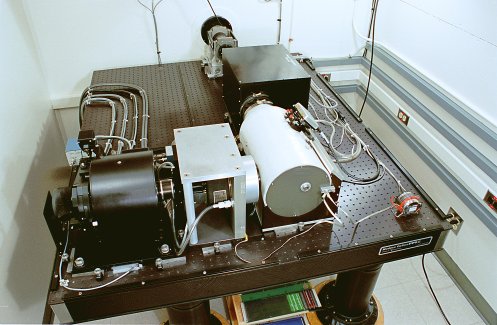
You can see the images these telescopes take at the
In order to find the pulsations, the GONG team takes light from the Sun
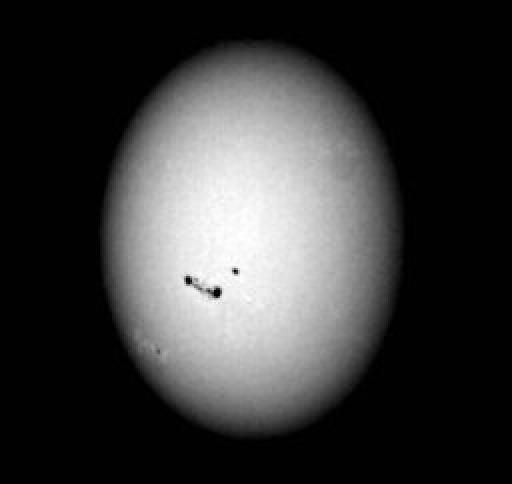
and uses its spectrograph to measure the motions of the gas via the Doppler effect. In the image below, white means "motion towards us", and black means "motion away from us".
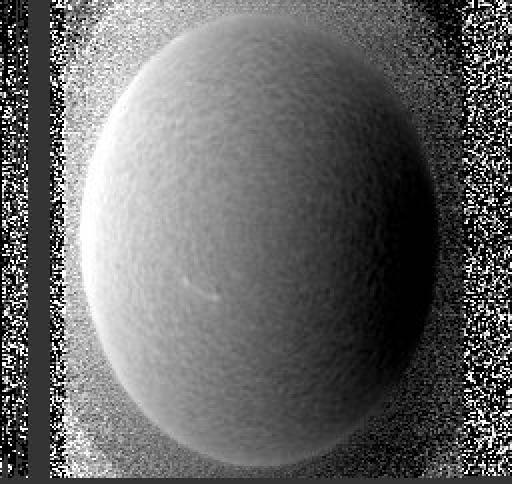
You can see
Here's a nicer picture showing the effect:

By analyzing the small features, astronomers can figure out how sound waves move through the solar interior:
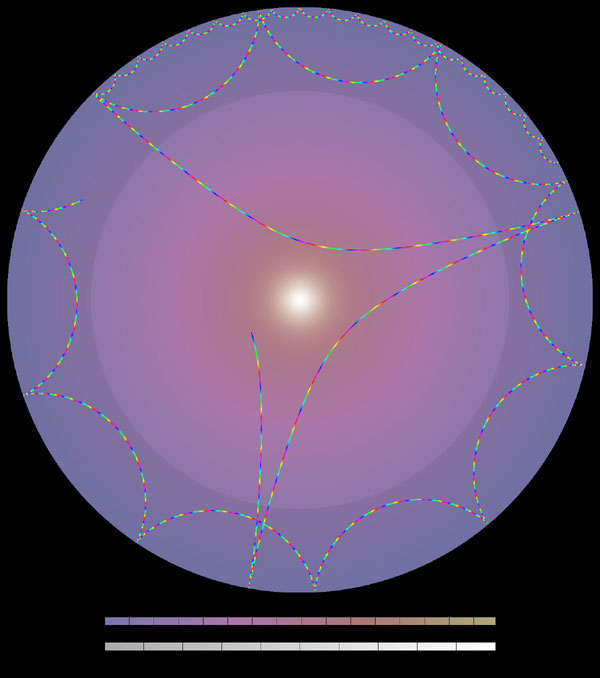
Some of these waves move through the outer portions of the Sun, but others dive deep towards the core. The waves travel through the interior of the Sun at the local sound speed, just as sound waves on Earth travel through the air. Where the solar material is very dense, they move quickly; there the density is low, they move slowly. Very careful analysis of months and years of data allows scientists to compare their models for sound speed (which depends on density, temperature, and chemical composition) within the solar interior to the real thing. And the models are pretty darn good!
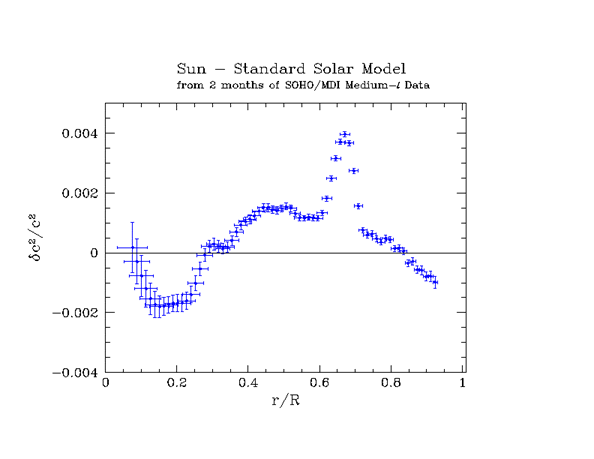
Note from the figure above that some of the sound waves probe very close to the center of the Sun, to within a distance only one-tenth the solar radius. But they don't get all the way into the core ...
At the center of the Sun, the temperatures are so high (around ten million degrees) that atomic nuclei can fuse together. One set of reactions called the "P-P chain" has the net result of turning four hydrogen nuclei (protons) into a single helium nucleus.
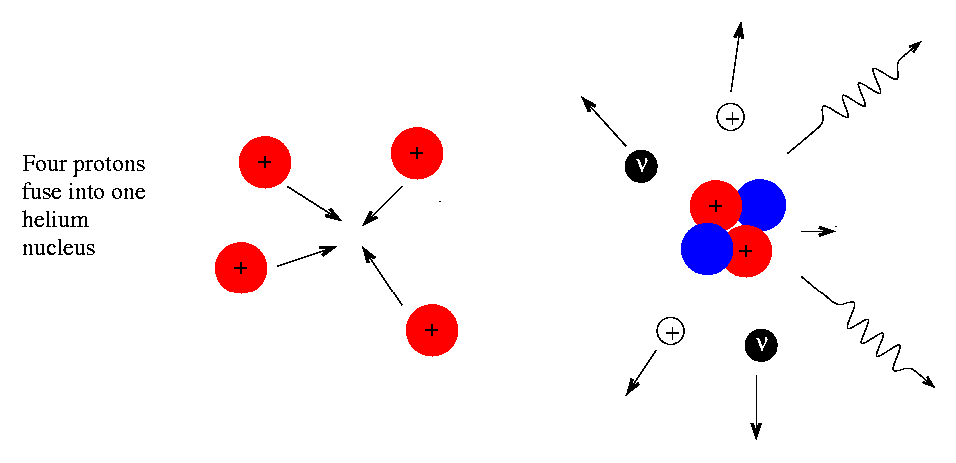
The mass of a helium nucleus is just a little bit smaller than that of four protons:
mass of 1 proton p = 1.67358 x 10^(-27) kg mass of 4 protons 4p = 6.6943 x 10^(-27) kg mass of helium nucleus He = 6.6466 x 10^(-27) kg -------------------------------------------------------------- difference 4p - He = 0.0477 x 10^(-27) kgThe "missing" mass, about 0.7 percent of the original protons' mass, turns into energy according to Einstein's famous equation
2
E = mc
This looks like a tiny amount of energy for each reaction, and it is. But there are a LOT of hydrogen atoms in even a small amount of matter. A single kg of hydrogen, for example, contains about 600 million billion billion atoms.
Q: The small cup I am currently holding
contains about 0.05 kg of water.
How much of this mass is hydrogen?
If we could fuse all the hydrogen
into helium, how much energy would be
released? Remember that only 0.7 percent
of the hydrogen's mass is converted into energy...
For comparison, note that a small (10-kiloton) atomic bomb yields about 4 x 1013 Joules of energy.
Note that the fusion reactions create 2 neutrinos (the little black particles). These neutrinos are a "flavor" called "electron neutrinos" -- note that electrons are involved in the reaction. The neutrinos are able to fly out of the solar core, through the entire solar interior, and out into space. With our neutrino telescopes here on Earth, we can detect some of them -- a very tiny fraction, but enough to check our models for fusion reactions in the solar interior.
The first neutrino telescope was built in the Homestake Mine in North Dakota, under the direction of Ray Davis. It is a giant vat of cleaning fluid.

On the very rare occasions when a neutrino interacts with one of the chlorine atoms in the fluid, it converts the chlorine into an atom of argon. Argon, a gas, bubbles to the top of the vat, where it can be collected and measured. The argon created in this process, Ar-37, is radioactive, and decays with a half-life of 35 days. It's relatively easy to detect when it decays, which is a good thing -- because only about one atom of argon is created per day!
The Homestake detector started operating in 1967. Over several decades, it built up a decent sample of detections. But the numbers were always smaller than expected. In fact, the "telescope" only detected about one-third the expected number of neutrinos.
From a paper by Bahcall, Cleveland, Davis, and Rowley, ApJ Lett, 292, 79 (1985): expected number of events (in a wierd set of units):
![]()
measured number of events:

People built new, bigger neutrino telescopes, such as GALLEX, which uses a vat of the liquid metal gallium instead of cleaning fluid.
The reactions involving gallium are different than those involving chlorine; this telescope is sensitive to neutrinos of somewhat lower energy than the Homestake telescope. But the problem didn't go away:

Was our theory of fusion incorrect? Was our model of the solar interior wrong? Physicists were growing a little worried ...
In the 1990s, scientists started using a new type of detector, based on the passage of a neutrino through large volumes of water:
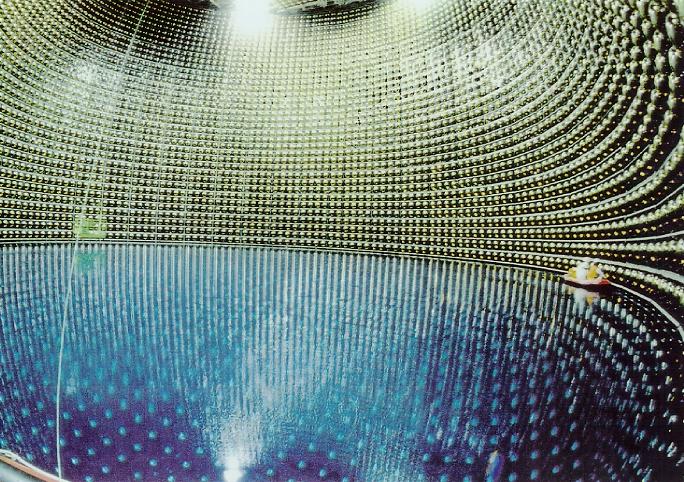
These new telescopes are able to detect not only the electron neutrinos which are created in the fusion reactions, but also the two other flavors, called "muon neutrinos" and "tau neutrinos". Those should NOT be created in the ordinary fusion reactions at the core of the Sun.
Nonetheless, the new detectors saw not only electron neutrinos, but also some of the other varieties. And, in fact, if you add up all three varieties of neutrino, you get just about the number which fusion theory predicts ought to be created.
It turns out that neutrinos can and do switch between three "flavors": electron, muon, and tau. Any particular neutrino will spend about 1/3 of its time in each state, randomly swapping from one to the other. Until very recently, all our neutrino telescopes could only see the electron neutrinos -- so we were missing two-thirds of the total.
For more information
 Copyright © Michael Richmond.
This work is licensed under a Creative Commons License.
Copyright © Michael Richmond.
This work is licensed under a Creative Commons License.